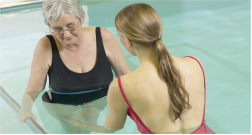
Aquatic therapy gives an advantage in the treatment of some cases involving osteoarthritis, gait rehabilitation, balance training, post -surgical rehabilitation, back pain, fibromyalgia, and more. The advantages of aquatic therapy largely revolve around the issues of temperature, water pressure, and – most importantly – buoyancy. Our aquatic therapy pool is maintained at a warm temperature. The warm temperature combined with the compressive nature of water results in muscle relaxation, reduced muscular guarding, decreased spasm, decreased pain sensitivity, and increased joint motion. The effects of the warm pool facilitate greater motion in the joints and muscles requiring rehabilitation.
The buoyancy provides a number of advantages. In the case of injury or post-surgical rehabilitation, the buoyancy creates adjustable, partial weight bearing. Submersion to the level of the anterior superior iliac spine creates a 54% weight reduction. Deeper submersion increases the weight reduction. In addition, submersion decreases the amount of muscle activation required for independent motion by as much as 75%. The partial weight bearing effect allows for earlier, independent range of motion for issues such as shoulder rehabilitation.
The buoyancy also allows patients to practice upright postures and functional patterns that might not be fully possible on land (e.g. in cases of geriatric disability, stroke, multiple sclerosis, Parkinson’s, cerebral palsy, etc.). Weight reduction can provide needed support to joints that would have been painful in full weight bearing and that would have inhibited therapy progress. During gait training, buoyancy greatly decreases the speed of falls. Slower falling not only increases patient confidence; it gives patients greater opportunity to detect postural errors and to practice recovery.
Aquatic therapy has been connected with improved outcomes for a number of conditions such as:
- Gait Deficits and General Balance
- Low Back Pain
- Rheumatic Disease – especially osteoarthritis of the hip and knee, and fibromyalgia
- Stroke, Parkinson’s, multiple sclerosis, cerebral palsy When you see patients with these challenges, consider the advantages available through aquatic therapy.

